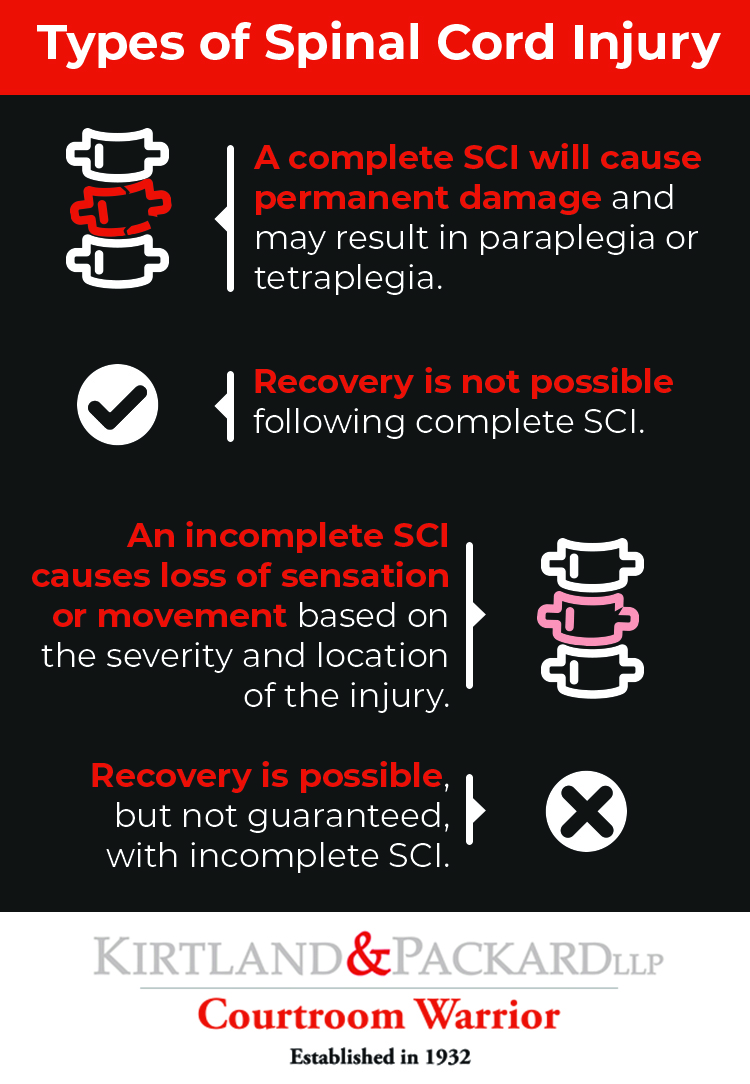Spinal cord injury (SCI) can be permanent depending on the location and severity of the injury. The type of SCI sustained, in addition to the health and medical history of the patient, will play the largest roles in determining the permanence of the injury.
Parts of the Spine
The spine is broken into four parts:
- Cervical Spine: from the shoulders to the base of the skull
- Thoracic Spine: from the mid-back to the space in between the shoulder blades
- Lumbar Spine: from the low-back to the mid-back
- Sacral Spine: from the tailbone to the low-back
There are 31 pairs of spinal nerves exiting from the spinal column. Each pair of nerves has a motor root, responsible for carrying signals to muscles, and a sensory root, responsible for sensory perceptions such as touch, position, and pain.
What Happens When the Spine is Damaged?
There are two types of SCI:
- Complete. Complete spinal cord injury occurs when the spinal cord is severed and will result in a complete loss of function
- Incomplete. Incomplete spinal cord injury occurs when the spine is damaged but not severed, and may result in a partial loss of function
The consequences of SCI depend both on the severity and location of the injury.
Damage to the cervical spine may result in paralysis of the hands, trunk, and legs, difficulties breathing, and loss of bowel and bladder control. Tetraplegia or quadriplegia may occur with cervical SCI.
Thoracic SCI may result in paraplegia, little to no control of bowel and bladder, and loss of sensation in the abdomen and chest.
Damage to the lumbar spine may result in loss of function in the legs and hips, and loss of bowel and bladder control.
Sacral spine injuries may result in a loss of function in hips and legs, a loss of bowel and bladder control, and a loss of sexual function.
Depending on the nerves impacted by the injury, additional complications of SCI may include a loss of skin sensation, poor respiration and blood circulation, muscle atrophy, and osteoporosis.

SCI Prognosis
When SCI is incomplete, there is the chance of recovery. Treatment options for this type of spinal cord injury may include:
- Surgical intervention
- Spinal traction
- Physical therapy
- Steroid injections
It is important to remember that treatment for SCI actually begins before medical intervention – by staying completely still. This is why, on the scene of an accident, we are advised not to move people until EMTs have arrived. Damage can often be minimized when the spine is kept immobile.
Even when treatable, it may not be possible to regain complete function following SCI. This can result in the need for adaptive technology, such as wheelchairs, changes in both lifestyle and work abilities, and increased risk for heart attack, deep vein thrombosis, and chronic pain. When SCI is the result of an accident you did not cause, you have a right to hold the negligent party accountable and seek compensation for medical expenses, lost wages, home modifications and adaptive technologies, and emotional and physical pain and suffering.
Kirtland & Packard can Help
The personal injury lawyers at Kirtland & Packard have decades of experience helping victims of SCI get compensation that takes into account the full extent of damages. Dedicated and tenacious, our SCI attorneys have the resources necessary to build strong and effective cases, and the experience needed to successfully litigate these complex cases.
If you have sustained a spinal cord injury in an accident in Redondo Beach, Torrance, or surrounding areas of California, call Kirtland & Packard at (310) 536-1000 to schedule a complimentary case evaluation and learn more about your rights and your options.
